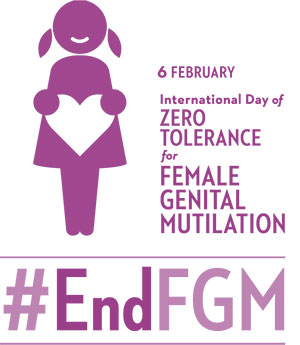 Today is International Day of Zero Tolerance to Female Genital Mutilation. The United Nations has sponsored this awareness day annually since 2003. Female genital mutilation (FGM) is the removal of all or some of the external female genitalia, including the removal of the clitoris, labia and/or closure of the vulva. The procedure differs depending on the country and ethnic group. FGM is practiced worldwide, although it is most common in Africa, Asia and the Middle East.
Today is International Day of Zero Tolerance to Female Genital Mutilation. The United Nations has sponsored this awareness day annually since 2003. Female genital mutilation (FGM) is the removal of all or some of the external female genitalia, including the removal of the clitoris, labia and/or closure of the vulva. The procedure differs depending on the country and ethnic group. FGM is practiced worldwide, although it is most common in Africa, Asia and the Middle East.
In a September 2016 study, UNICEF estimated that 200 million girls and women alive today in 30 different countries have undergone FGM. Let that sink in for a minute: 200 million girls and women.
The procedure is conducted anywhere from days after birth to puberty and on older girls as well. The practice is rooted in gender inequality. The aim is to control the sexuality of women and the practice builds upon traditional ideas of purity and modesty. The FGM procedure also comes with many health effects. These include infections, chronic pain, cysts, childbirth complications and fatal bleeding. FGM has no health benefits for girls and women according to a World Health Organization 2016 publication.
International efforts to end the procedure began in the 1970s. FGM has since been banned or restricted in most of the affected countries. Yet the practice continues to impact girls and women around the globe.
In addition to national legislation in many countries, international treaties and conventions have condemned FGM. UNICEF has outlined possible treaties that the practice violates, including Article 25 of the Universal Declaration of Human Rights and the Convention on the Rights of the Child.
In 2017, the United Nations Population Fund (UNFPA) is partnering with UNICEF to lead the largest global effort to end FGM. The current U.N. program focuses on 17 African countries and supports other regional and global initiatives. The U.N. reports that if current trends continue, 15 million more girls between the ages of 15 and 19 will have the procedure by 2030.
However, there has been some promising change. A 2016 UNICEF graphic using data from 2004 to 2015 shows that the percentage of girls aged 15 to 19 who have undergone FGM has declined. They report that not all countries surveyed have made progress, and the pace has been uneven, but overall the numbers are going down. In 1985, roughly 51 percent of girls aged 15 to 19 had been subjected to the procedure. Today, the figure is roughly 37 percent. Put another way, around 1 in 3 girls have had the procedure as opposed to 1 in 2 in the mid-1980s.
The annual day of awareness and zero tolerance for FGM is a much-needed reminder that efforts to end the practice have come so far in a relatively short period of time. But there is still much to be done in terms of education and providing comprehensive reproductive health care to eradicate the procedure. For the sake of girls around the world, it is my hope that the prevalence of FGM will continue to decline well into the 21st century.
All girls deserve the right to control their own bodies and take charge of their own futures. I hope on this day of global FGM awareness, world leaders and everyday people are consciously reminded of that fact and it spurs them to make change in their own communities.
-Sage Daugherty
Junior Girl
Girl Museum Inc.
